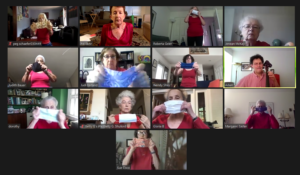
Members of Arts for the Aging’s Quicksilver Senior Improv Dance Company led by Teaching Artist Nancy Havlik with Music Director Adam Gonzalez during the July 13, 2020 Open House Rehearsal performing Mask Dance.
How do you transition a non-profit arts organization from over 600 in-person workshops a year to an almost completely digital format? Like all businesses, Arts for the Aging is finding new ways to complete our mission of providing therapeutic, multi-disciplinary arts programming for older adults and caregivers. Some challenges are unique to our situation. Our target audience is a population most vulnerable to the ravages of the coronavirus pandemic. Our faculty of teaching artists includes many seniors who are also at a higher risk. To add to these challenges, I began working with Arts for the Aging as Program Director at the beginning of May 2020 – three weeks into the stay-at-home order that shut down all in-person programs.
What type of person chooses to take on a new position in such circumstances? Definitely one who isn’t afraid of challenges. If there was no pandemic, I would be spending a lot of time driving to client partner sites to meet teaching artists, partner contacts, and to observe programs. Now everything is happening over my webcam from the comfort of my home office. As of the time of writing this blog, I have seen my boss, masked and at a distance, two times. I have met three of the 25 teaching artists, masked and at a distance, to hand off materials for our heART Kits. Although I have spent hundreds of hours on Zoom calls with them and more, the difficulties of digitally building relationships and a community at a distance cannot be trivialized.
While physical distance is a huge impediment in programing, it has also created opportunities to connect and train our teaching artists in new ways. Because of the broad geographical reach of our programs, many of the Arts for the Aging Teaching Artistshad not had the opportunity to regularly interact. Unless there was a mentor/mentee relationship, many had not observed others’ programs. Now with the development of our pre-recorded programs (ten-minute samples of programs available to client partners), teaching artists can observe and learn from each other. Collaborations and rehearsals over Zoom are now normal and highly anticipated.
Zoom is now a noun, an adjective, and a verb. We all know the basics of how to use it. Webinars, virtual happy hours, and digital birthday parties are part of our everyday lives. Where the transition to digital programs seemed daunting and the cause of great emotional upheaval, we have now proven how adaptable the organization, the teaching artists, the client partners, and our audience are.
The joke about seniors and their lack of competence with technology should be retired. I have been consistently impressed with how open to change our teaching artists and audience of older adults and caregivers have been during this transition. Where once some were saying “I’ll never get this, I think my time working with Arts for the Aging is over” now they are actively participating in planning programs and providing online support during rehearsals. I loved to see the sheer joy on the faces of a group of senior dancers when I explained how to ‘pin’ a speaker on their iPads during a Zoom call. We all want to learn, grow, and be creative no matter our age.
Tune in next month when we will explore how Arts for the Aging is reaching client partners offline and how access to technology should not be a limiting factor to access to quality arts programing.
